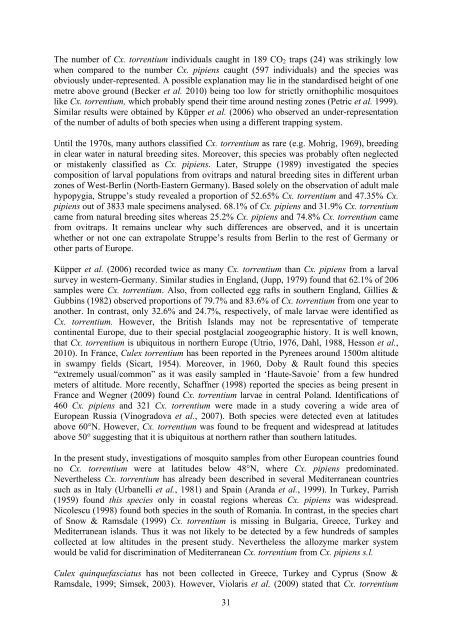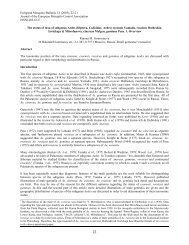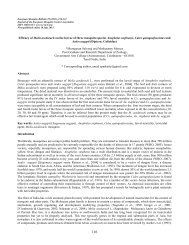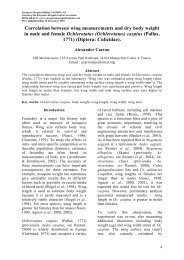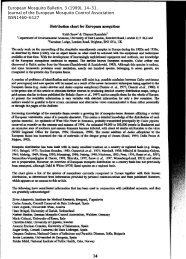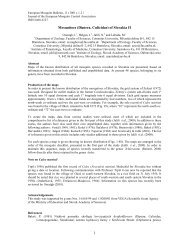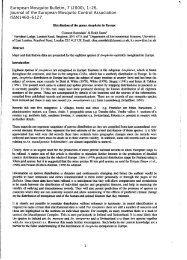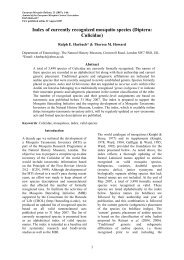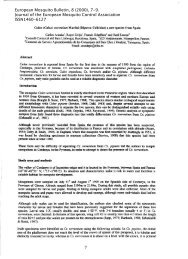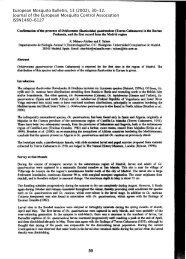22 Distribution and frequency of Culex pipiens and Culex torrentium ...
22 Distribution and frequency of Culex pipiens and Culex torrentium ...
22 Distribution and frequency of Culex pipiens and Culex torrentium ...
Create successful ePaper yourself
Turn your PDF publications into a flip-book with our unique Google optimized e-Paper software.
The number <strong>of</strong> Cx. <strong>torrentium</strong> individuals caught in 189 CO 2 traps (24) was strikingly lowwhen compared to the number Cx. <strong>pipiens</strong> caught (597 individuals) <strong>and</strong> the species wasobviously under-represented. A possible explanation may lie in the st<strong>and</strong>ardised height <strong>of</strong> onemetre above ground (Becker et al. 2010) being too low for strictly ornithophilic mosquitoeslike Cx. <strong>torrentium</strong>, which probably spend their time around nesting zones (Petric et al. 1999).Similar results were obtained by Küpper et al. (2006) who observed an under-representation<strong>of</strong> the number <strong>of</strong> adults <strong>of</strong> both species when using a different trapping system.Until the 1970s, many authors classified Cx. <strong>torrentium</strong> as rare (e.g. Mohrig, 1969), breedingin clear water in natural breeding sites. Moreover, this species was probably <strong>of</strong>ten neglectedor mistakenly classified as Cx. <strong>pipiens</strong>. Later, Struppe (1989) investigated the speciescomposition <strong>of</strong> larval populations from ovitraps <strong>and</strong> natural breeding sites in different urbanzones <strong>of</strong> West-Berlin (North-Eastern Germany). Based solely on the observation <strong>of</strong> adult malehypopygia, Struppe’s study revealed a proportion <strong>of</strong> 52.65% Cx. <strong>torrentium</strong> <strong>and</strong> 47.35% Cx.<strong>pipiens</strong> out <strong>of</strong> 3833 male specimens analysed. 68.1% <strong>of</strong> Cx. <strong>pipiens</strong> <strong>and</strong> 31.9% Cx. <strong>torrentium</strong>came from natural breeding sites whereas 25.2% Cx. <strong>pipiens</strong> <strong>and</strong> 74.8% Cx. <strong>torrentium</strong> camefrom ovitraps. It remains unclear why such differences are observed, <strong>and</strong> it is uncertainwhether or not one can extrapolate Struppe’s results from Berlin to the rest <strong>of</strong> Germany orother parts <strong>of</strong> Europe.Küpper et al. (2006) recorded twice as many Cx. <strong>torrentium</strong> than Cx. <strong>pipiens</strong> from a larvalsurvey in western-Germany. Similar studies in Engl<strong>and</strong>, (Jupp, 1979) found that 62.1% <strong>of</strong> 206samples were Cx. <strong>torrentium</strong>. Also, from collected egg rafts in southern Engl<strong>and</strong>, Gillies &Gubbins (1982) observed proportions <strong>of</strong> 79.7% <strong>and</strong> 83.6% <strong>of</strong> Cx. <strong>torrentium</strong> from one year toanother. In contrast, only 32.6% <strong>and</strong> 24.7%, respectively, <strong>of</strong> male larvae were identified asCx. <strong>torrentium</strong>. However, the British Isl<strong>and</strong>s may not be representative <strong>of</strong> temperatecontinental Europe, due to their special postglacial zoogeographic history. It is well known,that Cx. <strong>torrentium</strong> is ubiquitous in northern Europe (Utrio, 1976, Dahl, 1988, Hesson et al.,2010). In France, <strong>Culex</strong> <strong>torrentium</strong> has been reported in the Pyrenees around 1500m altitudein swampy fields (Sicart, 1954). Moreover, in 1960, Doby & Rault found this species“extremely usual/common” as it was easily sampled in ‘Haute-Savoie’ from a few hundredmeters <strong>of</strong> altitude. More recently, Schaffner (1998) reported the species as being present inFrance <strong>and</strong> Wegner (2009) found Cx. <strong>torrentium</strong> larvae in central Pol<strong>and</strong>. Identifications <strong>of</strong>460 Cx. <strong>pipiens</strong> <strong>and</strong> 321 Cx. <strong>torrentium</strong> were made in a study covering a wide area <strong>of</strong>European Russia (Vinogradova et al., 2007). Both species were detected even at latitudesabove 60°N. However, Cx. <strong>torrentium</strong> was found to be frequent <strong>and</strong> widespread at latitudesabove 50° suggesting that it is ubiquitous at northern rather than southern latitudes.In the present study, investigations <strong>of</strong> mosquito samples from other European countries foundno Cx. <strong>torrentium</strong> were at latitudes below 48°N, where Cx. <strong>pipiens</strong> predominated.Nevertheless Cx. <strong>torrentium</strong> has already been described in several Mediterranean countriessuch as in Italy (Urbanelli et al., 1981) <strong>and</strong> Spain (Ar<strong>and</strong>a et al., 1999). In Turkey, Parrish(1959) found this species only in coastal regions whereas Cx. <strong>pipiens</strong> was widespread.Nicolescu (1998) found both species in the south <strong>of</strong> Romania. In contrast, in the species chart<strong>of</strong> Snow & Ramsdale (1999) Cx. <strong>torrentium</strong> is missing in Bulgaria, Greece, Turkey <strong>and</strong>Mediterranean isl<strong>and</strong>s. Thus it was not likely to be detected by a few hundreds <strong>of</strong> samplescollected at low altitudes in the present study. Nevertheless the allozyme marker systemwould be valid for discrimination <strong>of</strong> Mediterranean Cx. <strong>torrentium</strong> from Cx. <strong>pipiens</strong> s.l.<strong>Culex</strong> quinquefasciatus has not been collected in Greece, Turkey <strong>and</strong> Cyprus (Snow &Ramsdale, 1999; Simsek, 2003). However, Violaris et al. (2009) stated that Cx. <strong>torrentium</strong>31


